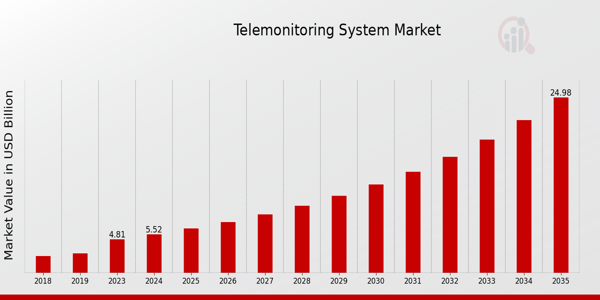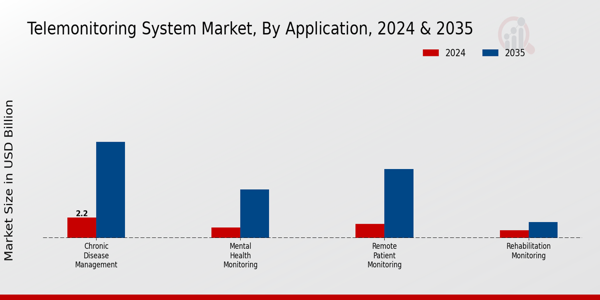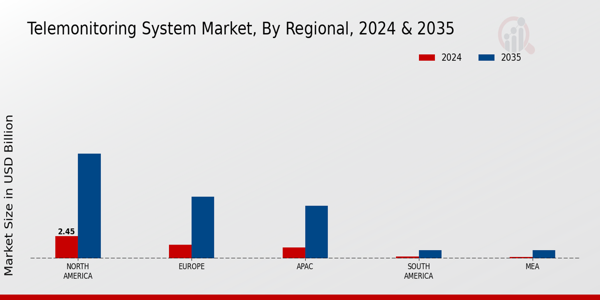Global Telemonitoring System Market Overview
As per MRFR analysis, the Telemonitoring System Market Size was estimated at 4.81 (USD Billion) in 2023.The Telemonitoring System Market Industry is expected to grow from 5.52(USD Billion) in 2024 to 25.0 (USD Billion) by 2035. The Telemonitoring System Market CAGR (growth rate) is expected to be around 14.71% during the forecast period (2025 - 2035).
Key Telemonitoring System Market Trends Highlighted
The Telemonitoring System Market is being driven by several key factors. The increasing prevalence of chronic diseases is a significant driver, leading to greater demand for remote patient monitoring to manage health conditions effectively. As healthcare systems strive to improve patient outcomes while reducing costs, telemonitoring offers solutions that enhance access to healthcare services. The rise of digital health initiatives, coupled with advancements in technology like wearable devices and mobile applications, further supports the growth of this market. Additionally, the ongoing shift towards value-based care models encourages the adoption of telemonitoring systems to facilitate continuous patient engagement.
There are various opportunities to be explored within the telemonitoring system market. As healthcare providers aim to improve operational efficiency, there are chances for innovation in system integration and data analytics that can provide actionable health insights. Expanding internet connectivity and the growing adoption of smartphones present avenues for reaching underserved populations and enhancing patient participation in their health management. Furthermore, the increasing emphasis on preventive care creates opportunities for solutions that can help in the early detection and intervention of health issues. In recent times, the market has seen notable trends, such as the integration of artificial intelligence and machine learning into telemonitoring systems, improving the accuracy and efficiency of remote health assessments.
The COVID-19 pandemic has accelerated the adoption of telehealth services, leading to a greater acceptance of remote monitoring technologies. Additionally, the trend toward personalized medicine is being reflected in telemonitoring solutions that offer tailored health management plans catering to individual patient needs. These evolving dynamics point to a vibrant and rapidly evolving landscape in the Telemonitoring System Market, presenting both challenges and opportunities for stakeholders.

Source: Primary Research, Secondary Research, MRFR Database and Analyst Review
Telemonitoring System Market Drivers
Increasing Demand for Remote Patient Monitoring
The Telemonitoring System Market Industry is widening where the remote patient monitoring systems are creating demand from every corner of the world. The cost while improving the patient’s outcomes are ever increasing which make remote monitoring technologies an ever important factors. These systems offer the ability for healthcare professionals to remotely track a patient’s vital signs, patients with chronic conditions, and other health issues which is extremely useful considering the growing population, older people, and the number of patients suffering from chronic diseases.
The changes within the telemonitoring solutions as they have become more convenient and easier to access than ever before have resulted in a shift from geographic telemonitoring care towards remote management which makes interventions faster and much more effective. Telemonitoring has grown to be much faster, easier, and more convenient for providers as well as patients, which make them more likely to switch to it. Furthermore, remote monitoring systems allow for better health care in a much more constructive manner which lets the patients actively participate in looking after themselves.
The joining of telemonitoring with mobile health applications improves this interaction even more, as it helps patients to keep track of their health and interact with their healthcare professionals. And, being able to provide the service right at home, increases the patient's satisfaction greatly because it reduces the hospital visits they need to go through, particularly for those who cannot travel far or stay in countryside areas.
This increases the likelihood that these systems will grow, because supported by technology and greater accessibility, there is a demand for these services, and healthcare policies that are becoming more supportive of value based care.
Technological Advancements in Digital Health Solutions
The emergence of advanced technologies such as artificial intelligence, machine learning, and the Internet of Things (IoT) is significantly propelling the Telemonitoring System Market Industry forward. These innovations enhance the capabilities of telemonitoring solutions, allowing for real-time data collection, analysis, and management. With AI-driven analytics, healthcare providers can gain deeper insights into patient conditions, leading to more informed treatment decisions.
Enhanced data accuracy and actionable insights contribute to better health outcomes and more efficient care delivery. Furthermore, IoT devices facilitate seamless communication between patients and healthcare providers, fostering a more interactive and responsive healthcare environment. As technology continues to evolve, the quality and functionality of telemonitoring systems are expected to improve, driving greater acceptance among users.
Rising Incidence of Chronic Diseases
The increasing prevalence of chronic diseases such as diabetes, cardiovascular disorders, and respiratory illnesses is a major driver of the Telemonitoring System Market Industry. With the global population experiencing demographic changes and longer life expectancies, there is a heightened need for effective management of chronic conditions. Telemonitoring systems empower patients and providers to closely monitor disease progression, adherence to treatment plans, and overall health metrics.
The ability to detect early signs of complications can lead to timely interventions and reduce the burden on healthcare systems. This growing awareness and necessity for chronic disease management are encouraging healthcare organizations to invest in telemonitoring technologies, propelling the market growth.
Telemonitoring System Market Segment Insights
Telemonitoring System Market Application Insights
The Telemonitoring System Market is positioned for substantial growth, especially within the Application segment, which includes areas such as Chronic Disease Management, Mental Health Monitoring, Remote Patient Monitoring, and Rehabilitation Monitoring. This segment is crucial as it reflects the increasing demand for continuous healthcare monitoring and management, contributing significantly to the overall market revenue. In 2024, the market for Chronic Disease Management is valued at 2.2 USD Billion, which supports its relevance, as chronic diseases require regular monitoring to prevent complications.
By 2035, this value is expected to rise to 10.5 USD Billion, indicating a major emphasis on proactive healthcare in response to the rising prevalence of chronic conditions. Additionally, Mental Health Monitoring, valued at 1.1 USD Billion in 2024 and projected to reach 5.3 USD Billion by 2035, highlights the growing recognition of mental health and the need for reliable tracking methods for behaviors and conditions that affect mental well-being. This segment reflects an awareness and responsiveness to social changes, including shifts in how mental health issues are addressed in society.
Remote Patient Monitoring is also a significant player, with a valuation of 1.5 USD Billion in 2024, expected to surge to 7.5 USD Billion by 2035, emphasizing its importance as healthcare systems increasingly rely on technology to track patients outside of clinical settings, providing timely interventions and enhancing patient outcomes. Lastly, Rehabilitation Monitoring stands at 0.82 USD Billion in 2024 and is estimated to grow to 1.7 USD Billion by 2035, showing its critical role in helping patients recover from injuries and surgeries through continuous support and tracking.
Each of these areas contributes uniquely to the Telemonitoring System Market data, representing robust growth drivers and highlighting opportunities fueled by technological advancements and increasing healthcare provider recognition of the need for comprehensive patient monitoring solutions. Overall, the Application segment showcases significant growth potential intertwined with the evolution of healthcare delivery systems, making it an essential focus for stakeholders in the Telemonitoring System Market industry.

Source: Primary Research, Secondary Research, MRFR Database and Analyst Review
Telemonitoring System Market Component Insights
The Telemonitoring System Market, valued at 5.52 billion USD in 2024, is experiencing robust growth driven by advancements in technology and increasing healthcare demands. Among the various components, software plays a crucial role in facilitating data integration and analytics for efficient patient monitoring. Its significance is underscored by the growing need for remote patient management solutions, resulting in a notable contribution to the overall revenue. Hardware components necessarily include devices that collect and transmit vital signs, serving as the backbone of telemonitoring systems.
Services such as installation and support further enhance user experience and ensure system efficacy. As the market evolves, these components will increasingly integrate to create a unified and user-friendly telemonitoring experience, propelling the market growth. Market trends indicate a rising preference for comprehensive telehealth solutions that include these components, ultimately shaping the landscape of the Telemonitoring System Market. The expected growth rate is supported by increasing chronic disease prevalence and a heightened focus on patient-centric healthcare models.
Overall, the Telemonitoring System Market's segmentation highlights the essential interdependencies among these components as they collectively advance healthcare delivery.
Telemonitoring System Market End User Insights
The Telemonitoring System Market, particularly within the End User segment, is steadily progressing, with expectations to reach a value of 5.52 billion USD by 2024. This segment has become increasingly important as healthcare shifts towards more remote and accessible solutions. Hospitals represent a significant portion of this market, leveraging telemonitoring systems to enhance patient monitoring and reduce healthcare delivery costs. Home Care Settings are also gaining traction, driven by the growing preference for in-home healthcare services, allowing for better patient comfort and personal care.
Diagnostic Centers utilize these systems to streamline processes and improve diagnostic accuracy, thus playing a critical role in patient care pathways. Additionally, Telehealth Providers have seen substantial growth as they offer flexible monitoring solutions to patients and enhance access to specialists. The interplay of these End Users demonstrates the versatility and applicability of telemonitoring solutions, reflecting a broader trend toward digital health integration. Overall, the Telemonitoring System Market statistics portray a landscape that is not only expanding but also adapting to the needs of different healthcare delivery models.
Telemonitoring System Market Technology Insights
The Telemonitoring System Market is projected to reach 5.52 billion USD in 2024, demonstrating robust growth driven by advancements in technology. This market encompasses various methods of data delivery, with technologies such as Cloud-Based solutions, On-Premise systems, and Mobile Applications playing crucial roles in their expansion. Cloud-Based solutions are particularly significant due to their ability to offer scalability, accessibility, and cost-effectiveness, facilitating real-time data sharing among healthcare professionals and patients.
On-Premise systems, while less flexible, provide enhanced control over sensitive patient data, which is a crucial factor in healthcare settings. Meanwhile, Mobile Applications cater to the increasing demand for convenience and immediate access to monitoring tools, enabling users to manage their health effectively. The diverse segmentation within the Telemonitoring System Market highlights the industry's versatility, catering to various needs and preferences in the healthcare sector, thereby fostering overall market growth.
Telemonitoring System Market Regional Insights
The Telemonitoring System Market is expected to experience notable growth across various regions. By 2024, North America is projected to hold a significant majority with a valuation of 2.45 USD Billion, rising to 11.5 USD Billion by 2035, underscoring its dominance in this industry. Europe follows, valued at 1.5 USD Billion in 2024 and expected to reach 6.8 USD Billion by 2035, highlighting its role as a vital market for telemonitoring. The APAC region, valued at 1.2 USD Billion in 2024, is anticipated to grow to 5.8 USD Billion, revealing the increasing adoption of telemonitoring solutions driven by technological advancements and a growing elderly population.
South America and MEA demonstrate smaller markets, with valuations of 0.2 USD Billion and 0.17 USD Billion in 2024, respectively, growing to 0.9 USD Billion by 2035, which presents both challenges and opportunities for market penetration and innovation in these regions. The continuous push for remote healthcare solutions due to the demand for efficient patient management further propels the overall market growth and segmentation in this landscape.

Source: Primary Research, Secondary Research, MRFR Database and Analyst Review
Telemonitoring System Market Key Players and Competitive Insights
The Telemonitoring System Market has seen significant advancements in technology and an increase in demand as healthcare practitioners and organizations recognize the importance of remote patient monitoring. The competitive landscape is characterized by a variety of players, including established corporations, innovative startups, and technology-driven firms that are striving to enhance the quality of care while reducing costs. Stakeholders are focusing on developing integrated solutions that encompass wearables, mobile applications, and cloud-based platforms to provide real-time health data to patients and clinicians alike. This expansion is supported by an increase in chronic diseases, an aging population, and a shift towards value-based healthcare, creating a highly competitive environment where companies must differentiate their offerings to capture market share.
GE Healthcare stands out in the Telemonitoring System Market as a leading player known for its innovative solutions and strong brand presence. The company's extensive experience in medical imaging and information technology provides it with a unique advantage in developing integrated telemonitoring systems. GE Healthcare offers a variety of telemonitoring products designed to facilitate remote patient management effectively, thus enhancing patient outcomes. The company excels in leveraging advanced analytics and machine learning capabilities to derive actionable insights from healthcare data. This approach not only aids healthcare providers in making informed decisions but also supports proactive patient engagement. With a firm commitment to research and development, GE Healthcare continuously improves its offerings, ensuring they align with evolving market demands and regulatory standards, thereby solidifying its position in the telemonitoring landscape.
IBM has also made a significant mark in the Telemonitoring System Market, utilizing its cutting-edge technology and data analytics capabilities to provide robust telehealth solutions. The company’s involvement in cognitive computing and artificial intelligence positions it uniquely to analyze vast amounts of health data effectively, enabling healthcare providers to deliver tailored patient care. IBM's telemonitoring systems are integrated with cloud technology, facilitating seamless data exchange and real-time monitoring, making it indispensable for remote patient management. The emphasis on security and compliance in its solutions helps address the critical concerns of patient privacy and data integrity, providing reassurance to healthcare organizations. Additionally, IBM's strategic partnerships with various healthcare entities further enhance its market presence and capabilities, fostering collaborative efforts in developing comprehensive telemonitoring solutions that empower healthcare providers to optimize patient care delivery.
Key Companies in the Telemonitoring System Market Include
- GE Healthcare
- IBM
- Bosch Healthcare Solutions
- Tunstall Healthcare
- Teleflex
- VitalConnect
- Philips
- AT and T
- Siemens Healthineers
- Honeywell
- Nokia
- Omron Healthcare
- Abbott
- Cardinal Health
- Medtronic
Telemonitoring System Market Industry Developments
Significant developments in the Telemonitoring System Market have emerged recently, reflecting advancements in technology and rising demand for remote patient monitoring solutions. Companies such as GE Healthcare, Philips, Siemens Healthineers, and IBM are continuously innovating and expanding their telemonitoring offerings to enhance patient care management. Growth has been observed in market valuation as organizations introduce advanced telemonitoring solutions that leverage artificial intelligence and IoT technologies, influencing an upward trajectory in the sector. Key players like Medtronic and Teleflex are actively collaborating on new technologies to improve monitoring capabilities. Additionally, noteworthy mergers and acquisitions have occurred, with companies like Honeywell and Abbott expanding their portfolios to include telemonitoring systems, reflecting a trend toward consolidation in the industry. The integration of telemonitoring systems with existing healthcare infrastructures is also on the rise, driven by the increasing focus on personalized healthcare and the management of chronic diseases. Furthermore, the recent partnerships between Tunstall Healthcare and regional healthcare providers are enhancing service delivery, showcasing a collaborative approach to optimizing telemonitoring applications in various markets. These dynamics collectively emphasize a robust and evolving landscape for telemonitoring systems globally.
Telemonitoring System Market Segmentation Insights
- Telemonitoring System Market Application Outlook
- Chronic Disease Management
- Mental Health Monitoring
- Remote Patient Monitoring
- Rehabilitation Monitoring
- Telemonitoring System Market Component Outlook
- Software
- Hardware
- Services
- Telemonitoring System Market End User Outlook
- Hospitals
- Home Care Settings
- Diagnostic Centers
- Telehealth Providers
- Telemonitoring System Market Technology Outlook
- Cloud-Based
- On-Premise
- Mobile Applications
| Attribute/Metric Source: |
Details |
| MARKET SIZE 2023 |
4.81(USD Billion) |
| MARKET SIZE 2024 |
5.52(USD Billion) |
| MARKET SIZE 2035 |
25.0(USD Billion) |
| COMPOUND ANNUAL GROWTH RATE (CAGR) |
14.71% (2025 - 2035) |
| REPORT COVERAGE |
Revenue Forecast, Competitive Landscape, Growth Factors, and Trends |
| BASE YEAR |
2024 |
| MARKET FORECAST PERIOD |
2025 - 2035 |
| HISTORICAL DATA |
2019 - 2024 |
| MARKET FORECAST UNITS |
USD Billion |
| KEY COMPANIES PROFILED |
GE Healthcare, IBM, Bosch Healthcare Solutions, Tunstall Healthcare, Teleflex, VitalConnect, Philips, AT and T, Siemens Healthineers, Honeywell, Nokia, Omron Healthcare, Abbott, Cardinal Health, Medtronic |
| SEGMENTS COVERED |
Application, Component, End User, Technology, Regional |
| KEY MARKET OPPORTUNITIES |
Growing demand for remote patient monitoring, Integration with AI and machine learning, Rising incidence of chronic diseases, Increasing healthcare cost containment initiatives, Expansion of Internet of Things (IoT) devices |
| KEY MARKET DYNAMICS |
Increasing demand for remote patient monitoring, Advancements in connected healthcare technologies, Rising prevalence of chronic diseases, Government support for telehealth initiatives, Growing aging population and caregiver shortages |
| COUNTRIES COVERED |
North America, Europe, APAC, South America, MEA |
Frequently Asked Questions (FAQ) :
The Telemonitoring System Market is expected to be valued at 5.52 USD Billion in 2024.
By 2035, the Telemonitoring System Market is projected to reach a value of 25.0 USD Billion.
The market is anticipated to grow at a CAGR of 14.71% between 2025 and 2035.
North America is expected to dominate the market with a projected value of 11.5 USD Billion by 2035.
The Chronic Disease Management application is valued at 2.2 USD Billion in 2024.
Mental Health Monitoring is projected to reach a market size of 5.3 USD Billion by 2035.
Major competitors include GE Healthcare, IBM, Bosch Healthcare Solutions, and Philips among others.
The Remote Patient Monitoring segment is valued at 1.5 USD Billion in 2024.
Rehabilitation Monitoring is expected to grow from 0.82 USD Billion in 2024 to 1.7 USD Billion by 2035.
The APAC region is expected to be valued at 1.2 USD Billion in 2024.

















